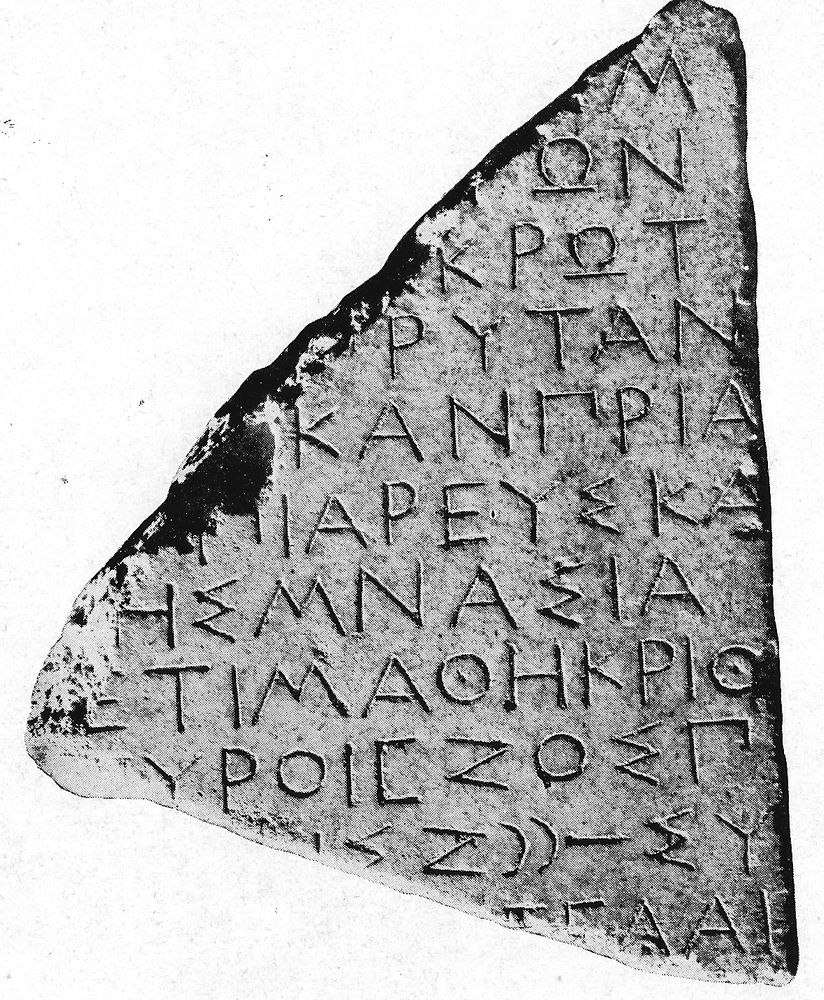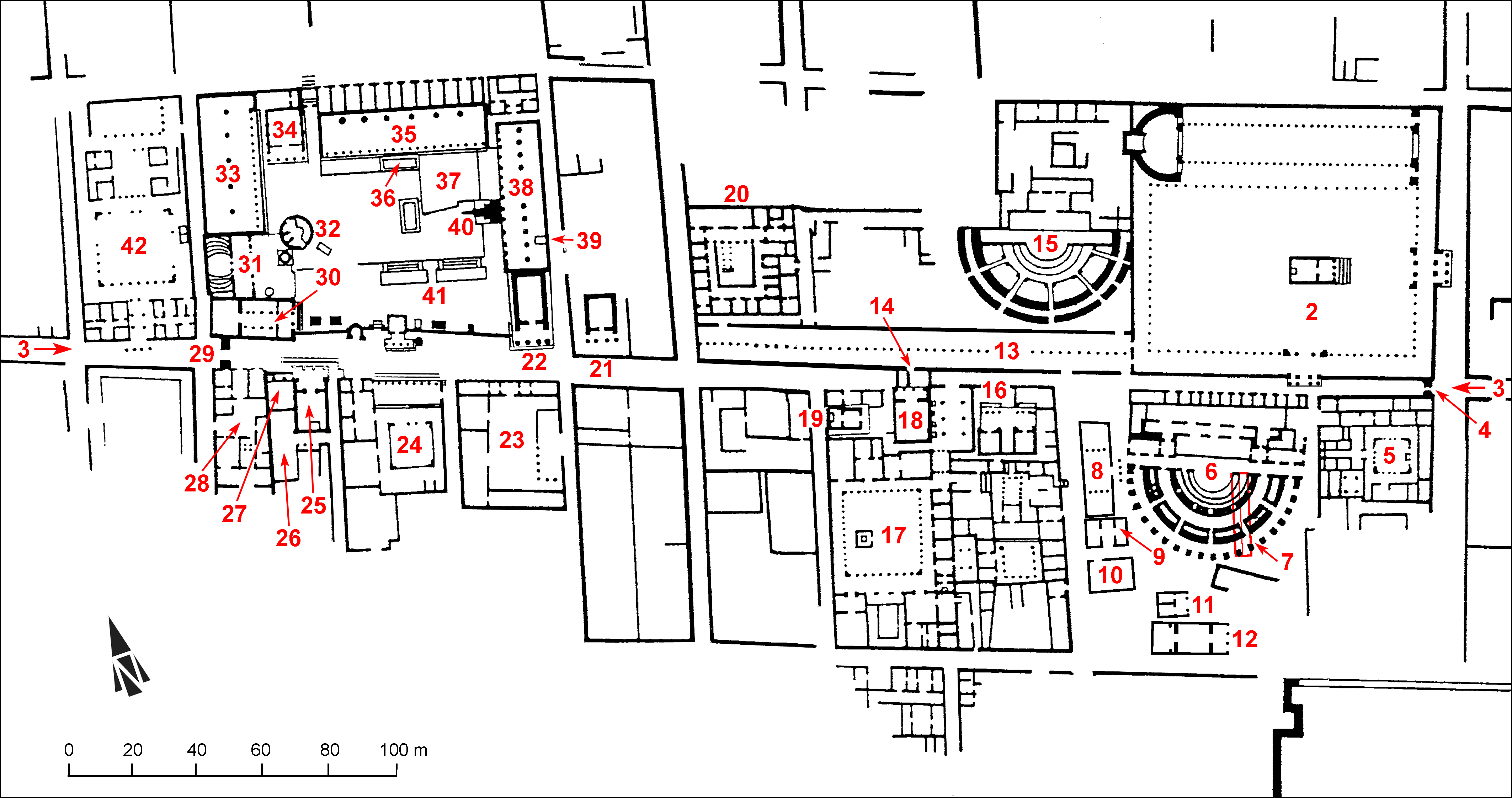EpiDoc XML:
IGCyr0125002
Trismegistos ID:
738212
Source description
Support: Right part of a white marble stele broken on top, left and below (w: 0.19 × h: 0.25 × d: 0.06).
Layout: Inscribedon the face.
Letters: 0.015; slanting mu and sigma.
Date: Between 365 and 360 BC (Rosamilia) (lettering, prosopography, content).
Findspot: Found at the latest in 1929 at Cyrene ➚: agora.
Place of origin: Findspot.
Last recorded location: Cyrene Museum, 357. Seen by C. Dobias-Lalou in 1976 in Shahat: Cyrene Museum.
Text constituted from: Transcription from stone (CDL) .
Bibliography
Oliverio 1932-1933, pp. 93-94, n. 22 (ph.), whence SEG, 9.23; IGCyr 012500 ➚; Rosamilia 2023, pp. 53 and 156 (content), pp. 162-167 (date), pp. 291-292, number 31 (text).
For general bibliography on the accounts of the damiergoi see IGCyr0114002.
Text
Apparatus
1: [---]ΑΜ: [Θεοί. Δαμιεργέντων Δ̣]αμ| Oliverio 1932-1933
2: [---]ΤΩΝ: [---], [Ἀρίσ?]των Oliverio 1932-1933; [--- δαμιεργέν?]των Oliverio 1932-1933
3: [---]ΑΚΡΩΤ|: [ος τοῦ δεῖνος, Βαλ?]άκρω Τ| Oliverio 1932-1933
4-5: [---]ΠΡΥΤΑΝ|[---]: π̣ρυταν|[ηιc. 8] Rosamilia 2023; [ἐν τῶι?] πρυταν|είω Oliverio 1932-1933; πρυτάν|[εις?] Oliverio 1932-1933
6: [ἐ]π᾿ ἱαρεῦς reading rejected by Oliverio: τ̣ι̣· ἱαρεὺς Rosamilia 2023; ΠΙ ἱαρεὺς Oliverio 1932-1933; ΠΙ ἱαρεῦς SEG
6-7: Κα|[c. 7]ης IGCyr (already Marengo 1991, pp. 179: Κα|[ρτισθέν?]ης Rosamilia 2023; Κα|[λλισθέν?]ης Oliverio 1932-1933
French translation
[---], sous la prêtrise de Ka[---]ès fils de Mnasias. [La récolte] a été estimée: orge, [tant]; froment, 3 drachmes; légumineuses, [tant]; raisins secs, 1 drachme 2 oboles 1/2; figues [tant]; olives [tant]; huile [tant]; [---].
English translation
[---], under priest Ka[---]es son of Mnasias. [The crops] were estimated: barley, [so much]; wheat, 3 drachmas; pulse, [so much]; raisins, 1 drachma 2 obols 1/2; figs [so much]; olives [so much]; oil [so much]; [---].
Italian translation
[---], sotto il sacerdote Ka[---]es figlio di Mnasias. [Il raccolto] è stato valutato: orzo, [tanto]; grano, 3 dracme; legumi, [tanto]; uva passa, 1 dracma 2 oboli 1/2; fichi, [tanto]; olive, [tanto]; olio, [tanto]; [---].
Arabic translation
[---]، تحت اشراف الكاهن كا [---] يس بن مناسياس، [المحاصيل] قدرت كالتالي: الشعير، [قيمة ما]. القمح، 3 دراخما؛ البقوليات، [قيمة ما]؛ الزبيب، 1 دراخما و½2 أوبول؛ التين [قيمة ما]؛ الزيتون [قيمة ما]. الزيت [قيمة ما]. [---].
Commentary
The few letters preserved at the end of lines 1-5 do not allow a secure restoration. At that place, we should await the mention 'Gods', followed by the names of the three damiergoi. At line 3, instead of Oliverio's Βάλακρος, unknown in Cyrenaica and typically Macedonian, one might prefer Φάλακρος, attested for a Cyrenaean in Mopsion (IG IX.2.1056), if only more letters were preserved. Alternatively, there exist a few compound names in -ακρος, which would be possible. At lines 4-5, the personal name Πρύτανις is possible, if followed by a short father's name. At the end of line 5 we might suggest the Libyan name Ελικαν; for the father the mythological names Πρίαμος, really too short, or preferably Πριαμίδας would be plausible. However, that does not fill all the space available and does not account for the vestiges at lines 1-2.
Another lead has been explored by Rosamilia 2023, p. 53 and 156. On behalf of the segment ΠΡΥΤΑΝ he supposes that the prytaneion is mentioned here, as well as, perhaps, its akroteria. As in IGCyr0111002, the damiergoi would be in charge of decorating the building serving as their office, namely the prytaneion. Lines 1-5 would thus be the vestiges of a decree preceding this account, which, in his view, is one of the most ancient of his first group, hence a date between 365 and 360 BC. This tatalizing view is on the whole as hypothetical as the preceding tentative one.
Line 7: the reading of elided ἐπί is sure, as pi is clear both from Oliverio's photograph and from Dobias-Lalou's squeeze. The priest's name is irregularly at the nominative case instead of the genitive. A similar irregularity may be found at IGCyr0118002. For the priest's own name, different restorations are possible besides Oliverio's Καλλισθένης, which is quite uncommon in Cyrenaica during the Hellenistic period. Rosamilia 2023, perhpas duly, chooses Καρτισθένης because it is most common in Cyrenaica. For a possible family relation with an Olympionikas of 464, see Rosamilia 2023, p. 162.
Line 10: the sign for 1/5 drachma, instead of being angular, has on that stone a lunate shape, like at IGCyr0136002.
CC BY-NC-SA 4.0 Deed Attribution-NonCommercial-ShareAlike 4.0 International License.
All citation, reuse or distribution of this work must contain a link back to DOI: https://doi.org/10.60760/unibo/igcyrgvcyr2 and the filename (IGCyr000000 or GVCyr000), as well as the year of consultation.


